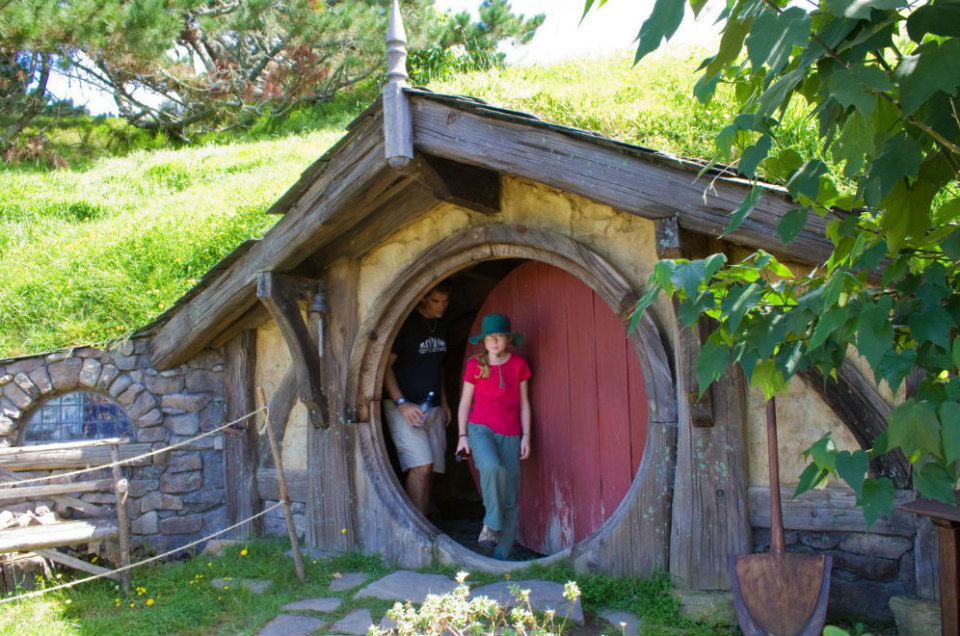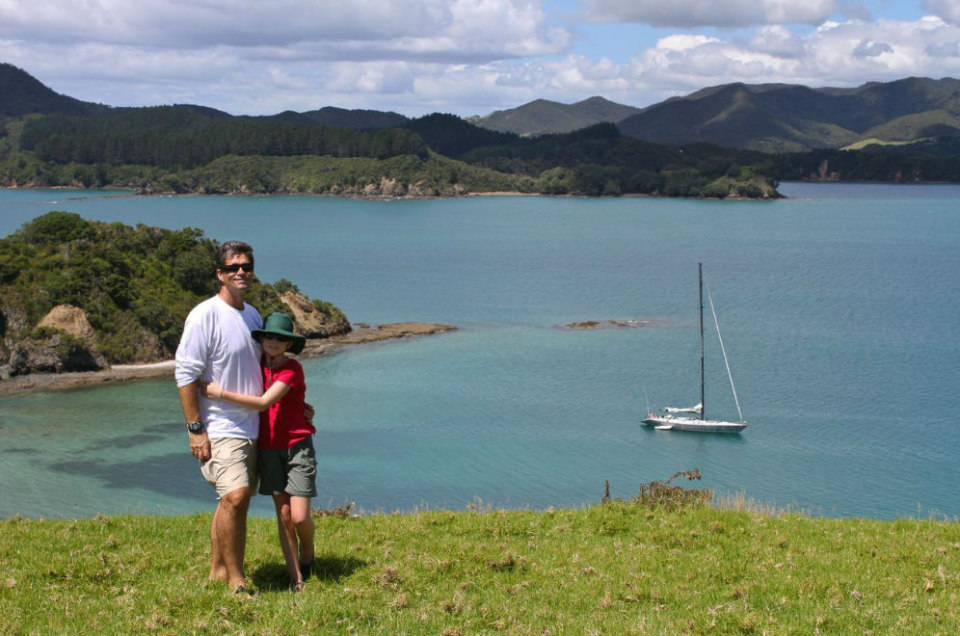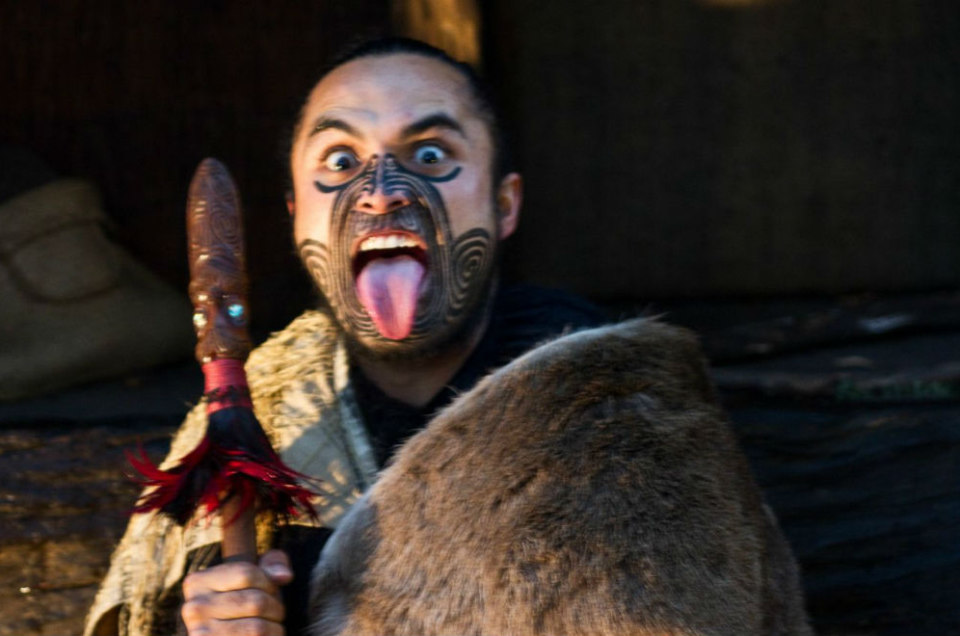Maia became silent when she caught sight of Tane Mahuta. Surprised by his staggering size my 10-year old daughter stopped singing and chattering and tilted her head up to see if she could even see the top of the Lord of the Forest.
Tane Mahuta is the tallest and largest kauri tree in New Zealand. According to Maori legend he’s the father of the forest and all that dwell in it. And Tane Mahuta is magnificent. The day we were there a steady stream of visitors made the pilgrimage to stand before him and marvel at both his girth and his sacred place in the Maori culture. Maia seemed especially awed. “It feels like he’s talking but I can’t quite hear him,” she said, leaning her ear closer to his ancient silvery trunk.
I’m not the type to believe in the supernatural. But we discovered that New Zealand is a land rich in spirit echoes, though in some ways to talk about them is tapu (the Polynesian word for taboo).
It’s probably not simply the oddness of imagining a tree (boat, building, beach…) imbued with a deeper energy that keeps us from saying such things out loud though. It’s perhaps these thoughts are simply too sacred for general conversation. The Maori, who are the first people of Aotearoa, land of the long white cloud (or New Zealand, as its come to be known) have many words for the energy of inanimate objects—my favorite is hau. Translated directly hau means wind, used differently it means the essence of something.
I was thinking these thoughts as we looked up at Tane Mahuta; imagining the tree’s hau and perhaps even feeling it. But then a big group of chattering visitors arrived and the spell was broken. We headed back to the road and to our rental car—we still had miles to drive to make to our next campsite before dark.
To see New Zealand adequately you need about six weeks. The goal is to travel clockwise, or anti clockwise, North Island, South Island, or a combo of both and set off exploring at a fairly leisurely pace. If, however, your trip to NZ is a quick visit from nearby Australia (as ours was), you need to develop a different strategy. We called ours the Sample NZ Tour. Much like in wine tasting, where you sip from a large number of varietals, vintages and vineyards (then try in vain to remember just which vineyard had the best Riesling on your next visit to the bottle shop…) in 10 days SNZ saw us circle out from Auckland up to the Bay of Islands, past the Tasman Sea, through the Waipoua Kauri Forest, to Rotorua and then back to Auckland.
Sailing in the bay
The 144 islands that make up the New Zealand Bay of Islands are best seen by boat. And when we learned the legendary 80’ maxi called Lion New Zealand ran day sails through the Ireland-green isles–we knew we had found our ride.
26-years ago, when I first met my now-husband Evan, he and I were captivated by the progress of this very yacht. It was speeding around the world as part of the Whitbread 1985-86 race (now the Volvo Around the World Race)—losing a leg here, gaining a leg there and all the while its Kiwi skipper, the late Sir Peter Blake was becoming an international hero. The race may have ended in Portsmouth, but our relationship didn’t, we were in love.
Maia giggled about descriptions of her then-younger parents falling in love over a sailboat race and I wondered if kids ever understand or appreciate love stories, especially when their parents are involved. But then she had a question about Lion. “What makes her feel so special?” she asked, hands on the wheel.
Maia seemed older and wiser as she eyed the sails and then tweaked the glorious old boat’s course, under the careful direction of the boat’s cheerful crew. As I watched her I wondered how much of a boat’s intrinsic magic is left behind by the vessel’s designers, builders, and the crew who urge her across a finish line. And how much of this (hau?) might be flowing through the wheel into Maia’s hands. Would Maia even understand what it was if it did make her finger tips tingle? Or would she think the tugging of the wheel was just the great boat feeling the surge from the breeze.
The Tasman to Rotorua
The Tasman Sea was windswept, wild and rugged. We stopped in at one of the immensely helpful local tourism offices to get directions to a walking trail. One suggestion would have taken us to dunes—sand hills that are more popular with dune surfers than hikers. Maia’s eyes lit up at the idea of hurtling down a huge sand slide, but having already felt the sting of grit blowing against my shins I was more inclined to walk on one of the wooded ridges.
From the Tasman we drove onward to Hobbiton, though the shire wasn’t our primary destination the way to was for Bilbo Baggins and so many of the movie’s fans. The movie set from Lord of the Rings 1 & 3 and was recently rebuilt for the Hobbit movies. Over 65,000 faithful show up each year (some in costume, we had an elf and a hobbit on our tour) and wander through the hobbit trails—walking in Gandalf’s footsteps or looking out through Frodo’s door, reciting lines from the movies.
Our true goal that day was the hot springs in Rotorua. Rotorua is where New Zealand’s tourism began. Early Europeans set out to take the waters—the natural thermal bathing pools created by geysers. Since that time the region has remained one of the main attractions in New Zealand—while at the same time the sacred waters have remained central to Maori culture.
A soak in the hot bubbling water felt good after all the travel but we weren’t done sampling. We set off horse riding through the rolling green countryside and past sheep and more sheep (and yes, there are more sheep in New Zealand than people). Then we visited a Kiwi recovery program and saw a newly hatched chick. One evening we headed out in the rain to Tamaki Maori Village for a cultural show and a hangi (a feast cooked in an underground oven).
A tourist show and dinner was the last place I expected to find a deeper connection to New Zealand. But as Maia snuggled against me for warmth and the music and dancing intermingled with the sounds of wind and rain, the building seemed the thrum with energy. “I’ll remember this night for my whole life,” Maia whispered, just before gasping in surprise as the warriors dancing the Haka thrust out their tongues.
Camping In New Zealand
With lodging options that range from bare bones Conservation Sites (often found in remote but beautiful locations) to full service Holiday Parks that have everything from tent sites to fully contained cottages—New Zealand is a campers paradise. We opted to rent a small car and carry a tent, but traveling the country in a self-contained camper van is also a popular way to travel in New Zealand.


